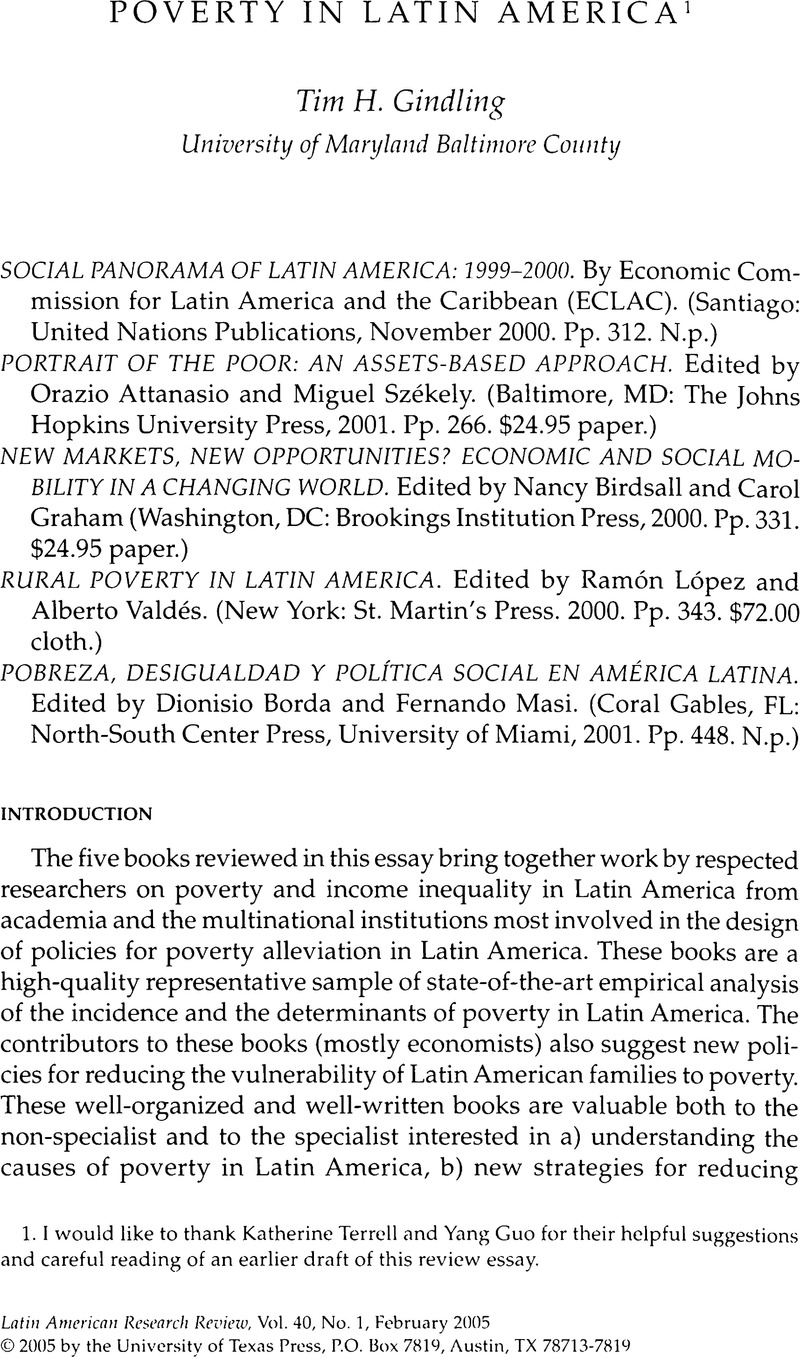Published online by Cambridge University Press: 05 October 2022

I would like to thank Katherine Terrell and Yang Guo for their helpful suggestions and careful reading of an earlier draft of this review essay.
2. Poverty rates for Latin American countries are reported by ECLAC, Social Panorama of Latin America (Santiago, Chile: United Nations Publications, various years). This report is published yearly, and the most recent report is available on the web site http://www.eclac.org. The 1999–2000 report, reviewed in this essay, presents poverty estimates for eighteen Latin American countries; Argentina, Bolivia, Brazil, Chile, Colombia, Costa Rica, Dominican Republic, Ecuador, El Salvador, Guatemala, Honduras, Mexico, Nicaragua, Panama, Paraguay, Peru, Uruguay and Venezuela. Of these, the highest poverty rates are reported in Bolivia, Guatemala, Honduras and Nicaragua while the lowest poverty rates are reported in Argentina, Chile, Costa Rica and Uruguay.
3. Miguel Székely. “The 1990s in Latin America: Another Decade of Persistent Inequality, but with Somewhat Lower Poverty,” Inter-American Development Bank Research Department Working Paper no. 454 (Washington, DC: IDB, 2001).
4. One influential publication that made this point was the Inter-American Development Bank's 1998 Report on Economic and Social Progress in Latin America, subtitled Facing Up to Inequality in Latin America: Economic and Social Progress in Latin America, 1998–1999 (Washington, DC: Johns Hopkins University Press, for IDB, 1998).
5. A 1998 article in this journal reviews the arguments for, and the outcomes of, this shift from universal to targeted social programs (see John Sheehan, “Changing Social Programs and Economic Strategies: Implications for Poverty and Inequality,” Latin American Research Review 33 (2): 185–196 (1998).
6. The authors of the country studies are: George Gray-Molina, Wilson Jimenez, Ernesto Pérez de Rada and Ernesto Yánez (Bolivia); Marcelo Cortes Neri, Edward Joaquim Amadeo and Alexandre Pinto Carvalho (Brazil); Dante Contreras and Osvaldo Larranaga (Chile), José Leibovich and Jairo Núnez (Colombia); Juan Diego Trejos and Nancy Montiel (Costa Rica); Javier Escobal, Jaime Saavedra and Máximo Torero (Peru).
7. PROGRESA “provides cash transfers and nutritional supplements to families in extreme poverty in rural areas. Cash transfers are conditioned on children's school attendance rates of at least 85 percent, and regular attendance at health clinics for checkups and follow-ups. The cash transfer is given to the mother, who also has to attend a series of courses on health practices. Bolsa Escola is a similar program that provides scholarships for disadvantaged children. Part of the cash transfer is held in a special account, which the beneficiary can access after completing a schooling cycle. Chile Joven is also a program of cash transfers, but in this case they are provided to young adults as a training incentive” (247).
8. The countries are Argentina, Bolivia, Brazil, Chile, Colombia, Costa Rica, Ecuador, El Salvador, Honduras, Mexico, Nicaragua, Panama, Paraguay, Peru, Uruguay, and Venezuela.
9. The Social Panorama of Latin America: 1999–2000 reports that a minimum of ten years of education is necessary to pull a person out of poverty.